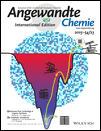Dynamic Inclusion Complexes of Metal Nanoparticles Inside Nanocups†
We are grateful to C. Miksch and J. P. Spatz for help with SEM, BCML, and the Tollens reactions. We thank the Stuttgart Center for Electron Microscopy for TEM support. We are grateful to A. G. Mark for constructing the 3D models of the nanostructures and H.-H. Jeong for helpful comments. This work was in part supported by the European Research Council (ERC Grant 278213). The authors declare no competing financial interest.
Graphical Abstract
Nanocup with nanoparticle: Dynamic 1:1 host–guest inclusion complexes of metal nanoparticles inside oxide nanocups are fabricated by means of a reactive double Janus nanoparticle intermediate in a kinetically controlled process. Release of the nanoparticle guests from the nanocups can be efficiently triggered by an external stimulus.
Abstract
Host–guest inclusion complexes are abundant in molecular systems and of fundamental importance in living organisms. Realizing a colloidal analogue of a molecular dynamic inclusion complex is challenging because inorganic nanoparticles (NPs) with a well-defined cavity and portal are difficult to synthesize in high yield and with good structural fidelity. Herein, a generic strategy towards the fabrication of dynamic 1:1 inclusion complexes of metal nanoparticles inside oxide nanocups with high yield (>70 %) and regiospecificity (>90 %) by means of a reactive double Janus nanoparticle intermediate is reported. Experimental evidence confirms that the inclusion complexes are formed by a kinetically controlled mechanism involving a delicate interplay between bipolar galvanic corrosion and alloying–dealloying oxidation. Release of the NP guest from the nanocups can be efficiently triggered by an external stimulus.





